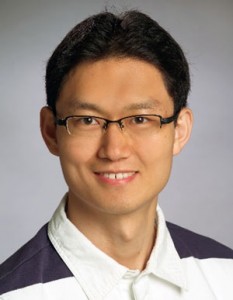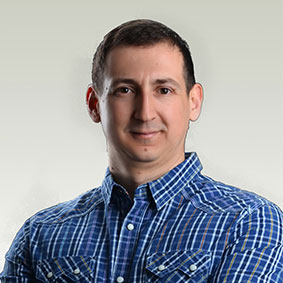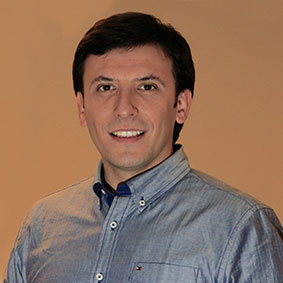iBG-izmir has recently welcomed new Assistant Professors
Yongsoo PARK
 Assistant Professor, Dr. Yongsoo Park was a postdoctoral fellow funded by research fellowship from Alexander von Humboldt Foundation with Prof. Dr. Reinhard Jahn (Neurobiology department, the Max Planck Institute for Biophysical Chemistry, Göttingen, Germany). Dr. Yongsoo Park studied Molecular Neurophysiology at POSTECH (Pohang University of Science and Technology) in South Korea, where he received his Ph.D. in 2009. During his Ph.D. work he received scholarships from KOSEF and KBS. In 2015, he received an EMBO Installation Grant.
Assistant Professor, Dr. Yongsoo Park was a postdoctoral fellow funded by research fellowship from Alexander von Humboldt Foundation with Prof. Dr. Reinhard Jahn (Neurobiology department, the Max Planck Institute for Biophysical Chemistry, Göttingen, Germany). Dr. Yongsoo Park studied Molecular Neurophysiology at POSTECH (Pohang University of Science and Technology) in South Korea, where he received his Ph.D. in 2009. During his Ph.D. work he received scholarships from KOSEF and KBS. In 2015, he received an EMBO Installation Grant.
What were you doing and where have you been?
I was studying a PhD at POSTECH researching exocytosis of catecholamine from chromaffin cells (sympathetic ganglia in the neuroendocrine system) using amperometry, electrophysiology, cell biology, and imaging techniques. Then I moved to the Max Planck Institute for Biophysical Chemistry for my postdoctoral training in 2009. I exploited biochemical and biophysical approaches to study the mechanisms of vesicle fusion, and thereby expanded my research capacity from the cellular to the biochemical and biophysical level in the field of vesicle fusion. These interdisciplinary techniques are the strong points of my research background.
What are your plans?
Vesicles containing neurotransmitters in neurons are nanomachines to deliver neurotransmitters because of its small size; e.g., synaptic vesicle, 45 nm in diameter. This size is much smaller than virus. To my knowledge, synaptic vesicle is the smallest organelle in life. I believe that the small size of vesicle plays a critical role in its biological function.
My overall goals are to translate basic research into diagnosis and therapeutics for psychiatric disorders by controlling neurotransmitter release using synthetic biology. Synthetic biology is an emerging scientific method to understand how life works. Bottom-up synthetic neurotransmission is an in vitro-based approach that uses minimal machinery to reconstitute vesicle fusion. By combining synthetic neurotransmission and the interdisciplinary techniques, I aim to develop chemical Botox or peptide Botox which selectively inhibits vesicle fusion in psychiatric disorder condition.
Why did you prefer iBG-izmir?
I am excited to contribute to iBG-izmir, a brand new institute in Turkey. I had interests in Turkey and heard about iBG-izmir, inspiring me to join iBG-izmir. I believe that science has no borders and iBG-izmir will be an international biomedical research center. iBG-izmir is an interdisciplinary research institute which fits in with my research goals.
In addition to its scientific potential, I also prefer beautiful weather of Izmir. I was surprised at trees along the street; mandarin, orange, and palm trees. Weather and food of Izmir are attractive. I would like to contribute to scientific innovation in iBG-izmir.
Şerif ŞENTÜRK
 Serif Senturk’s career has spanned from Bogazici University in Istanbul, to Bilkent University in Ankara and Cold Spring Harbor Laboratory (CSHL) in New York, United States. Serif Senturk received his bachelor’s degree in 2003 from Molecular Biology and Genetics Department at Bogazici University and moved on to earn a PhD degree at Bilkent University in the laboratory of Prof. Mehmet Ozturk. Main motive of his graduate studies was directed toward understanding molecular mechanisms underlying senescence response and acquired resistance of hepatocellular carcinoma cells to the regulatory cytokine TGF-beta.
Serif Senturk’s career has spanned from Bogazici University in Istanbul, to Bilkent University in Ankara and Cold Spring Harbor Laboratory (CSHL) in New York, United States. Serif Senturk received his bachelor’s degree in 2003 from Molecular Biology and Genetics Department at Bogazici University and moved on to earn a PhD degree at Bilkent University in the laboratory of Prof. Mehmet Ozturk. Main motive of his graduate studies was directed toward understanding molecular mechanisms underlying senescence response and acquired resistance of hepatocellular carcinoma cells to the regulatory cytokine TGF-beta.
Having gained research experience on cancer biology for more than six years in Turkey, he decided to continue his career on this field abroad. After finishing his PhD with several publications in peer-reviewed journals, he joined Cold Spring Harbor Laboratory in 2010. As a postdoctoral fellow with Prof. Raffaella Sordella for five years, his research at CSHL, explored a breathtaking scope of p53 field, culminating in a groundbreaking work in identification of a novel p53 isoform generated through alternative splicing, and its role in epithelial-mesenchymal transition. He performed several other projects in this laboratory as well as in collaboration with others addressing mechanisms of acquired drug resistance in non-small cell lung cancer. He also focused on developing a technology for genome engineering upon existing CRISPR/Cas9 technique to generate a powerful system which would be traceable and provide robust and temporally controlled gene editing.
After completing his postdoctoral career in late 2015, Serif Senturk joined International BioMedicine and Genome Institute (iBG-izmir). Here in Izmir, he is part of an invaluable team which will focus on investigating and developing biotechnological drugs such as monoclonal antibodies (mAb) mainly in the form of biosimilars and biobetter drugs. iBG-izmir has gathered a substantial number of scientists from all around the globe equipped with extensive research experience and incorporated them into the overall design of the facility. Specifically, the Biopharmaceutical Unit is designed to minimize downtime and maximize throughput and provide economically viable, long-term production of tomorrows life-saving medicines for relevant clinical operations. With this vision in mind, Serif Senturk is dedicated to succeed with utmost performance by working together with other members of the Institute in order to help achieve the goals of this center of excellence while also focusing on developing his career on a different angle of life sciences, translational research.
Serhat TOZBURUN
 Serhat Tozburun received his B.S. degree in Physics from Middle East Technical University in 2005, M.S. degree in Physics from Koc University in 2007, and Ph.D. degree in the Optical Science and Engineering from the University of North Carolina, Charlotte in 2012, respectively. In his PhD dissertation research, he worked on optical stimulation of prostate Cavernous nerves, using infrared laser radiation as a potential alternative for intraoperative identification and preservation of the Cavernous nerves to conventional nerve mapping devices. After graduation, he joined to the Wellman Center for Photomedicine at Massachusetts General Hospital and Harvard Medical School to participate in innovative research studies of the development of optically subsampled optical coherence tomography and a rapid, phase-stable optical coherence tomography system. At Wellman, he also focused on developing a method using novel apparatus for treatment of Barrett’s esophagus, which is a precancerous condition of esophagus and associated with esophageal cancer (adenocarcinoma of esophagus).
Serhat Tozburun received his B.S. degree in Physics from Middle East Technical University in 2005, M.S. degree in Physics from Koc University in 2007, and Ph.D. degree in the Optical Science and Engineering from the University of North Carolina, Charlotte in 2012, respectively. In his PhD dissertation research, he worked on optical stimulation of prostate Cavernous nerves, using infrared laser radiation as a potential alternative for intraoperative identification and preservation of the Cavernous nerves to conventional nerve mapping devices. After graduation, he joined to the Wellman Center for Photomedicine at Massachusetts General Hospital and Harvard Medical School to participate in innovative research studies of the development of optically subsampled optical coherence tomography and a rapid, phase-stable optical coherence tomography system. At Wellman, he also focused on developing a method using novel apparatus for treatment of Barrett’s esophagus, which is a precancerous condition of esophagus and associated with esophageal cancer (adenocarcinoma of esophagus).
Currently, he is a faculty in IBG-Izmir at Dokuz Eylul University. He believes IBG-Izmir is a perfect fit for him to leverage his career to the next level and notes three bullet-points to make IBG-Izmir a crystal-clear choice for him; a cross-disciplinary environment, stateof- the-art research infrastructures, and a strong perspective on creating translational research opportunities. At IBG-Izmir, he will start his own research laboratory, called Translational Biophotonics and Optical Imaging Lab. The broad goal of the research lab will be to develop and implement optical techniques and non-invasive optical coherence imaging modalities to address biomedical challenges.
Dr. Tozburun serves as a reviewer of the Journal of Biomedical Optics, Optics Express, Biomedical Optics Express, Optics Letter, and Current Molecular Imaging. He is also a member of the Institute of Electrical and Electronics Engineers – IEEE, the Optical Society of America – OSA, and the International Society for Optics and Photonics – SPIE. He has been awarded a 2012 Optics and Photonics Scholarship by SPIE for his potential contributions to the fields of optics, photonics, or related field. Dr. Tozburun holds two U.S. patents. He is a first-author of more than 20 papers published in refereed scientific journals and conference proceedings, and presented more than 15 abstracts
and conference presentations.

